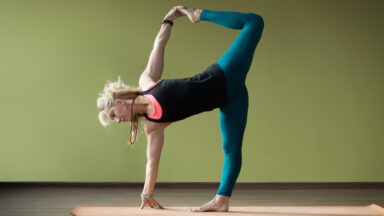How Mantra Transports The Mind’s Awareness to the Heart

In 2006, I enrolled in yoga teacher training. They sat us in a circle of 20 people and asked us to say our names and something fun about ourselves. My mouth got dry, my armpits started sweating, and like many introverts who are shy about public speaking, I waited to go last. By the time it was my turn, the nerves had totally built up.
I gave a terse introduction, all the while speaking through a shaky voice as I felt the nervous sweat dripping down my body. I realized I was terrified of speaking in front of my peers and loathed having all eyes on me. That evening I visited the leader and told him I was quitting teacher training.
It’s 2021 now and I can say honestly I’m glad he didn’t let me, but I am still, to this day, fearful of public speaking. During the first class I ever taught I received a comment card saying I had a robotic voice! But my motto ‘fake it until you make it’ one day turned into ‘fake it until you become it.’ That’s why I chose to continue to master my trade and teach yoga full time.
In 2009, I trained with Janet Stone at her very first teacher training where we sang and sang. I was introduced to the power of mantra. Maybe I loved it because I am half Filipina and lived in the Philippines—Filipinos love to sing! Maybe it was because my Dad, as a diplomat, played karaoke songs when I was little and I knew all the words to New York, New York by 5th grade. Ever since the training, mantra has been my savior.
What is Mantra?
Mantra experienced its first wave in the east during the 15th century. The second wave hit the West at the end of the 20th century and brought with it the Hare Krishna movement and its followers.
The Hare Krishna movement familiarized us with the singing of Sanskrit mantras or ‘Kirtan,’ meaning ‘to sing.’ Often it’s performed in a call-and-response style, as the devotional practice of singing or chanting. Sanskrit is an ancient language based on vibrations, so this chanting allows the body to actually feel specific energies.
A mantra is a phrase, whether in your preferred language or in Sanskrit. It’s a phrase you use to wake up certain dormant energies. Some examples of dormant energies may be presence, strength, courage, or power. We hold certain energies in our heart spirit that have magical and spiritual powers.
Mantra is a mental release. In a very short time, the mind can no longer resist past or future thinking. The mind gets coaxed into the present moment. ’Man’ means mind, and ‘tra’ means transport or vehicle. The mantra becomes a way to transport our mind’s awareness to our heart, which only knows the present moment.
Mantra and the Throat Chakra
One reason chanting mantra with my classes has been so helpful to me is because of the impact mantra has on the throat chakra. A chakra is an energy vortex, with the throat chakra being our fifth, or Vishuddha Chakra.
Negative energies, such as fear of public speaking, guilt, or insecurities will block the energy flow in the throat chakra, which allows for creative expression and honest communication. Speaking our truth cleanses blockages in the throat chakra.
Mantras Impact on the Nervous System
Mantra has also been effective in stimulating compassion. The vagus nerve originates in the brain stem and extends to the tongue, vocal cords, heart, and other internal organs. The vagus nerve is one of the most important elements of the parasympathetic nervous system. Existing in a parasympathetic state feels peaceful, present, and relaxed.
Mantras and Connection
A study was conducted on a church choir as they practiced their setlist to observe the effects of singing together. This study was done by scientists interested in seeing if joining together in music and song had any noticeable impact on a group of individuals.
It was discovered that when people get together and play music or sing, their brain waves connect. It was also discovered that their heartbeats synced as well. I love to tell yoga participants, whom I am lucky to chant with, that we are singing from one big, beating heart! And to never underestimate the power of the big heart and the intention being set.
If you’ve ever watched any shows or documentaries in search of the true meaning of happiness, they all come to the same conclusion; happiness is found in the community and through connection.
Regardless of whether you’re chanting a single OM with your class, or participating in a drum circle with strangers, the connection is there. Our voices come together as one. It doesn’t matter how well you think you can sing. It doesn’t matter how well you think your neighbor thinks you can sing, it’s about something bigger. It’s about feeling less alone and more connected to those you know and those you don’t.
Mantras for Beginners
I generally default to one of my favorite deities as a recommendation for a beginner to start using a mantra. Ganesha, the elephant-headed deity is known as the Remover of Obstacles and Lord of New Beginnings. He helps us see where we tend to get in the way of ourselves through fears, insecurities, and anxieties. His essence helps us dig deep into our courageous true nature to overcome these obstacles.
Ganesha is also associated with the Earth element. He connects us to Earth and helps us feel grounded when times are tumultuous. His mantra helps us feel safe and grounded.
If you are newer to Sanskrit and prefer to use English mantras, please use the following: ‘I am safe and grounded.’
One of the mantras to access the same feeling in Sanskrit is: ‘Om Gam Ganapatiyey Namaha.’
The sound of Om holds the three syllables of A, U, and M. These stand for beginnings, middles, and endings, and honors that everything is constantly changing. Gam is the seed sound for Ganesha. Or a sound that holds true to all of his energies. Ganapati(yey) is another name for Ganesha, and Namaha simply means ‘I call upon.’
OM GAM GANAPATIYEY NAMAHA.
I AM SAFE AND GROUNDED.
Use these mantras by saying them out loud, or silently to yourself. It doesn’t matter how many times you repeat them. But they are there to help you feel less overwhelmed and more connected to yourself and the Earth. Om Gam Ganapatiyey Namaha!
Studies Show Mantra Repetition Has Measurable Healing Effect

New studies show that repeating sacred sounds can have a powerful effect on your health and well-being.
The practice of mantra, or the repetition of sacred sounds, has been an integral part of many spiritual traditions throughout the ages. Today, exciting new research is scientifically validating the profound psychological and physiological benefits of this ancient practice.
Dr. Shamini Jain is a leader in the emerging field of biofield science and author of “Healing Ourselves.” She knows mantra repetition to be a highly effective tool for consciousness expansion and healing.
“Sometimes we get so bogged down in the conditioned mind that we find it harder to reach our spirit,” Jain said. “So, mantra is a tool for us to reach our spirit, whether we call that ‘God,’ ‘deep consciousness,’ ‘higher self’ — there are many names for it, but it’s really a technique for transcending the mind. And it can be something that’s spoken out loud, literally like repeating a word out loud, it can also be something that we repeat silently. It can also be sung, and many traditions — almost all global traditions really — have some type of practice where they utter sacred sounds.”
In ancient traditions, the primary function of mantra was to connect with the divine.
“In these traditions, there was a deep relationship of sound with consciousness. Working with mantras in these ancient traditions, it was leading you to expand your consciousness so that you can be in better contact with divinity,“ Jain said.





































